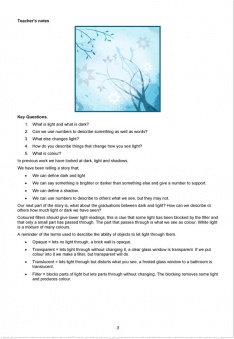Exploring Light: Difference between revisions
No edit summary |
mNo edit summary |
||
| Line 1: | Line 1: | ||
[[Category:Science]][[Category:Primary]] | [[Category:Science]][[Category:Primary]] | ||
{{Rinfo | {{Rinfo | ||
|title= | |title= Comparing light and dark | ||
|subject= | |subject= | ||
|topic= | |||
|tagline=Light can be light, dark or somewhere in between | |||
|image=Lightanddarkandsomewhere0.jpg | |||
|topic=Measuring | |||
|resourcenumber= SC0028 | |resourcenumber= SC0028 | ||
|age= | |age=primary age 7 | ||
|content= | |content= A teacher-led inquiry into how light or dark different places are. Discussion is helped by having a large display to show a 'bar chart' of the light level, thanks to a data logging device. This lesson introduces the idea of using numbers for light level and terms such as opaque; transparent and translucent. | ||
|format= | |format= | ||
|Learning Objectives = | |Learning Objectives = | ||
* | * understand that this sensor responds quickly to changes in light and provides a measurement | ||
* | * be aware that the sensor can detect light coming from different directions | ||
|strategy= | |strategy= | ||
|additional resources= Data Harvest | |additional resources= Requires any light sensor and a large display of its readings, for the whole group to see when the level changes. The activity was written around sensing equipment made by Data Harvest UK. http://dataharvest.co.uk | ||
|useful information= | |useful information= | ||
|related resources= | |related resources= | ||
Book of ICT-based activities [[IT_in_Primary_Science]] | |||
Book of activities using sensors [[Primary_Science_Curriculum_Activities_with_Sensors]] | |||
|other= | |other= | ||
|resources= [[file:Light dark and somewhere in between?.doc]] | |resources= [[file:Light dark and somewhere in between?.doc]] | ||
}} | }} | ||
[[File:Lightanddarkandsomewhere1.jpg|border|340x340px| | Preview snapshot ]] | |||
Revision as of 00:08, 12 September 2012
Lesson idea. A teacher-led inquiry into how light or dark different places are. Discussion is helped by having a large display to show a 'bar chart' of the light level, thanks to a data logging device. This lesson introduces the idea of using numbers for light level and terms such as opaque; transparent and translucent.
Teaching approach. This lesson involves the use of higher order questioning(ta) on scientific method(ta) topics to engage pupils in an inquiry(ta) relating to the nature of light, its measurement, and the use of sensors. (edit)
| Resource details | |
| Title | Comparing light and dark |
| Topic | [[Topics/Measuring|Measuring]] |
| Teaching approach | [[Teaching Approaches/Questioning|Questioning]], [[Teaching Approaches/Inquiry|Inquiry]], [[Teaching Approaches/Scientific method|Scientific method]] |
| Learning Objectives |
|
| Subject | [[Resources/Science|Science]] |
| Age of students / grade | [[Resources/Primary age 7|Primary age 7]], [[Resources/Primary|Primary]] |
| Additional Resources/material needed | Requires any light sensor and a large display of its readings, for the whole group to see when the level changes. The activity was written around sensing equipment made by Data Harvest UK. http://dataharvest.co.uk |
| Related ORBIT Wiki Resources | Book of ICT-based activities IT_in_Primary_Science Book of activities using sensors Primary_Science_Curriculum_Activities_with_Sensors |
| Files and resources to view and download |
|


